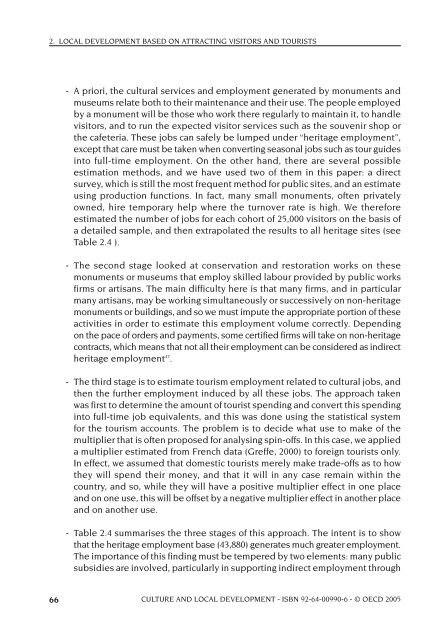OECD Culture and Local Development.pdf - PACA
OECD Culture and Local Development.pdf - PACA
OECD Culture and Local Development.pdf - PACA
Create successful ePaper yourself
Turn your PDF publications into a flip-book with our unique Google optimized e-Paper software.
2. LOCAL DEVELOPMENT BASED ON ATTRACTING VISITORS AND TOURISTS<br />
- A priori, the cultural services <strong>and</strong> employment generated by monuments <strong>and</strong><br />
museums relate both to their maintenance <strong>and</strong> their use. The people employed<br />
by a monument will be those who work there regularly to maintain it, to h<strong>and</strong>le<br />
visitors, <strong>and</strong> to run the expected visitor services such as the souvenir shop or<br />
the cafeteria. These jobs can safely be lumped under “heritage employment”,<br />
except that care must be taken when converting seasonal jobs such as tour guides<br />
into full-time employment. On the other h<strong>and</strong>, there are several possible<br />
estimation methods, <strong>and</strong> we have used two of them in this paper: a direct<br />
survey, which is still the most frequent method for public sites, <strong>and</strong> an estimate<br />
using production functions. In fact, many small monuments, often privately<br />
owned, hire temporary help where the turnover rate is high. We therefore<br />
estimated the number of jobs for each cohort of 25,000 visitors on the basis of<br />
a detailed sample, <strong>and</strong> then extrapolated the results to all heritage sites (see<br />
Table 2.4 ).<br />
- The second stage looked at conservation <strong>and</strong> restoration works on these<br />
monuments or museums that employ skilled labour provided by public works<br />
firms or artisans. The main difficulty here is that many firms, <strong>and</strong> in particular<br />
many artisans, may be working simultaneously or successively on non-heritage<br />
monuments or buildings, <strong>and</strong> so we must impute the appropriate portion of these<br />
activities in order to estimate this employment volume correctly. Depending<br />
on the pace of orders <strong>and</strong> payments, some certified firms will take on non-heritage<br />
contracts, which means that not all their employment can be considered as indirect<br />
heritage employment 47 .<br />
- The third stage is to estimate tourism employment related to cultural jobs, <strong>and</strong><br />
then the further employment induced by all these jobs. The approach taken<br />
was first to determine the amount of tourist spending <strong>and</strong> convert this spending<br />
into full-time job equivalents, <strong>and</strong> this was done using the statistical system<br />
for the tourism accounts. The problem is to decide what use to make of the<br />
multiplier that is often proposed for analysing spin-offs. In this case, we applied<br />
a multiplier estimated from French data (Greffe, 2000) to foreign tourists only.<br />
In effect, we assumed that domestic tourists merely make trade-offs as to how<br />
they will spend their money, <strong>and</strong> that it will in any case remain within the<br />
country, <strong>and</strong> so, while they will have a positive multiplier effect in one place<br />
<strong>and</strong> on one use, this will be offset by a negative multiplier effect in another place<br />
<strong>and</strong> on another use.<br />
- Table 2.4 summarises the three stages of this approach. The intent is to show<br />
that the heritage employment base (43,880) generates much greater employment.<br />
The importance of this finding must be tempered by two elements: many public<br />
subsidies are involved, particularly in supporting indirect employment through<br />
66 CULTURE AND LOCAL DEVELOPMENT - ISBN 92-64-00990-6 - © <strong>OECD</strong> 2005














